Sightron SII Blue Sky Binoculars — Binoculars With a "Cult" Following?
MenuAugust 2013
What do Sightron SII Blue Sky binoculars have that make demanding binocular users embrace them? As our regular readers already know, we like to look for those binoculars which will provide an above average optical value for their price.
We're familiar with quite a number of discriminating individuals who love both wildlife and the optics which enable them to be on intimate terms with it. Like us, they look for binoculars which are both excellent optical values and which are reasonably priced. These are individuals who are willing to spend a small fortune for optical excellence if they need to do so, but who relish a good deal as much as the next person. We noticed a lot of these folks embraced the Sightron SII Blue Sky binocular line, but we didn't find much discussion of those binoculars on the web. Perfect!
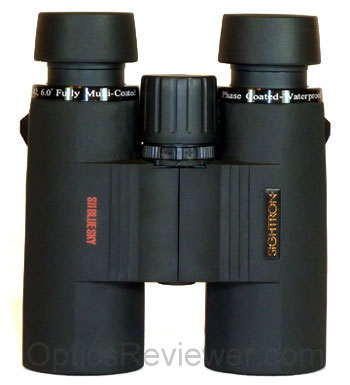
When we put our researcher (he's part of the team, but he's really good at finding information) to work to learn something of the company's history, we did find some information we thought was interesting. We're not sure why Sightron doesn't say more about it….
The company was initially incorporated in the state of Florida in December 1993. Its 1996 annual report filing in Florida shows five directors — two with addresses in North Carolina and three with addresses in Tokyo, Japan. When we looked at the most recent annual filing available to us in Florida for the company, all five of the addresses for directors or officers were in Tokyo, Japan.
In looking at the company's history in North Carolina, we found that Sightron's initial filing with the secretary of state was September 1995 and that it referenced the Sightron corporation in Florida. The most recent publicly available documents for Sightron in both North Carolina and Florida name the same person as president. Florida shows a Tokyo, Japan, address for him while North Carolina shows an address in North Carolina. We believe having an individual such as this, who subscribes to the company's Japanese corporate culture of high quality, is a good thing for Sightron binocular buyers in the United States.
What does it all mean? We understand it to mean that Sightron optics are designed and engineered by a solid company in Japan which got its start in the 1960s. Our research tells us that, until relatively recently, their optics were all made in Japan. Beyond these things, let's see what we found when we tested our Blue Sky binocular — let's get started with our review, shall we?
Please note that the company's name in the United States is simply Sightron, Inc. For clarity, however, we will refer to "Sightron USA" and "Sightron Japan."
Right out of the box, our Sightron SII Blue Sky 10X42 binocular was comfortable to hold with relatively short barrels helping to keep the weight of the binocular down. While we're talking about weight, our test instrument wasn't exactly featherweight, but it didn't feel as heavy as some binoculars in its weight class can. We attribute that to its balance. The "fit and finish" were good.
The binocular is well designed for balance and is easy to use for extended periods without excessive tiring of either the hands or forearms. In fact, the balance and size seemed to the Optics Reviewer team members to work together to make bringing the instrument to the eyes and locating the desired view intuitive. These are significant attributes for anyone who uses a binocular for more than just occasional viewing! We liked our test instrument's balance and considered it to be above average in that regard.
There is a difference in the appearance between the configurations with 32mm objective lenses and those with 42mm objective lenses. The rubber armoring on the binoculars with the smaller objective lenses is green, while the armoring on the larger configurations is black.
Update: At the 2014 Shot Show, we learned that Sightron USA had discontinued the SII Blue Sky binoculars with 42mm objective lenses. The configurations with 32mm objective lenses are still available due to their popularity.
The Sightron SII Blue Sky Binocular's Design
For those who need a binocular to be as easy to handle as possible, this full-size binocular is built compactly. The diameter of the barrels, including their rubber armoring, is as comfortable for small hands as well as large.
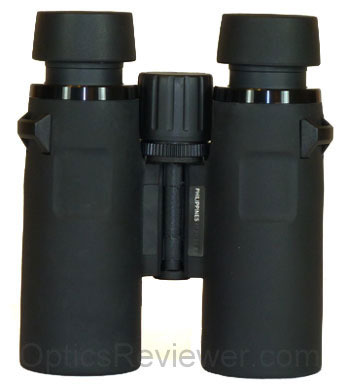
One complaint we have heard for the configurations with 32mm objectives is that the name plate (molded into the rubber armor) sticks out a bit from the rest of the body and is not as comfortable as it might be. Generally speaking, though, the feeling we've observed is that it's not uncomfortable enough to be a deal breaker. Our 10X42 configuration did not have any such bumps and was quite comfortable.
On the undersides of the barrels are indents in the rubber armor to gently guide the user's thumbs into position for optimal balance. While some people find indents beneficial, we've tended to ignore them if they aren't appropriately placed for an instrument's balance. With our SII Blue Sky binocular, we found that the indents seemed to be ideally placed for the instrument's balance and our thumbs seemed to naturally glide into them.
The rubber armor fulfills two functions: 1) it makes the binocular easier to hold with cold or wet hands, and 2) it protects the instrument from the occasional scrape or bump it's almost bound to encounter in use.
Of course, its design is not intended, and one wouldn't expect a relatively thin rubber coat, to protect a precision optical instrument from abuse. If a binocular is dropped or falls on the floor of our car or truck with any frequency, it will soon be evident in its functioning.
The Sightron SII Blue Sky's armor has a pleasant feel with enough friction from a "soft rubber feel" to make handling easy — even though the rubber seems quite tough and durable.
Aluminum Chassis
When we asked Sightron what kind of chassis the SII Blue Sky binoculars are built on, we were told it's an aluminum frame along with resins which provides strength at a reasonable price and weight. Our optical technician friends tell us that it's easier to work on binoculars with metal frames, so that would be a benefit to having the aluminum frame if something were to happen to your binocular.
Should you ever need to have your Blue Sky binocular collimated after suffering a significant drop, for example, you'll be relieved when you remember that your Blue Sky was designed to be as easy as reasonably possible to perform maintenance on.
We understand from owners or former owners of the 8X32 configuration that the weight specified on Sightron USA's web site is about 2.5oz (70.9g) heavier than the actual weight — when weighing them without lens caps or neck strap.
Waterproof/Fog-proof/Dustproof
As one might expect, given the present popularity of the roof prism binocular design, most binoculars available today are hermetically sealed. Through the use of O-rings and lubricants appropriate for a wide range of functioning temperatures, the binoculars are protected against water or dust getting inside.
Perhaps the problem presented by dust getting inside is obvious — that it would obscure our ability to see clearly with the binocular. The problem with water getting inside is just as bad and perhaps worse. Moisture will promote the growth of fungi which eat at the optical coatings of the lenses over time and produce internal fogging.
These Sightron binoculars have had the potentially moist air removed by filling the instrument with dry nitrogen gas just before they're sealed. As long as the instrument's seal is good, this eliminates the possibility of internal fogging. Of course, the outside lens surfaces of the eyepieces or objectives will still fog up when going from a cool temperature to a warmer, more humid atmosphere! That lens fogging clears away quickly, though, and isn't as detrimental to your binocular.
Eyecups and Eye Relief
The eyecups are of the twist-up variety and provide two intermediate detents between fully collapsed and fully extended. We found that, although they were serviceable, the detents were a bit soft and it wasn't always clear when the eyecups were set to the second or third position.
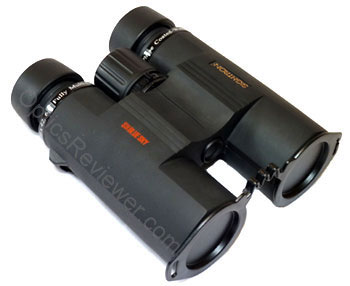
It would be nice to have a more crisp action that would clearly indicate when the eyecups are at their intermediate levels.
The levels of adjustment available for the eyecups are good for enabling one to adjust the eye relief to a comfortable distance. While this may be more often an interest of those wearing eyeglasses, our team found that the eye relief provided with our 10X42 configuration sometimes meant better usability with the eyecups less than fully extended.
This may be as good a place as any to discuss the interpupillary distance (IPD) range for the Blue Sky binoculars. We couldn't find this information anywhere in Sightron literature or on retail listings for the binocular, so we asked a Sightron representative. It's 54-75mm for the configurations with 32mm objective lenses and 54-76mm for those with 42mm objectives.
Center Focus
The focus wheel on our test binocular was pleasantly smooth with enough resistance to keep it from self-adjusting when we didn't want it to change. For those with deeply ingrained habits regarding which way to turn the focus wheel in focusing, our unit's wheel turned counterclockwise to go from close focus to infinity.
For those who enjoy being able to achieve a particularly fine focus, our Sightron SII Blue Sky 10X42 will likely prove a joy and delight. Our test model went from a close focus to infinity in about 1.75 turns of the focus wheel.
Our regular readers are likely prepared for our soapbox discourse on how a "fast" or "slow" focus impacts ones enjoyment of a binocular. While we hate to disappoint our regular readers, we'll simply note that a slow focus will give your fingers a workout when repeatedly changing a binocular's focus adjustment. On the other hand, too fast of an adjustment will result in missing views because it's difficult to achieve a fine focus quickly.
We like it when a single revolution of the focus wheel takes us from close focus to infinity. To show our flexibility, we're willing to compromise to 1.5 revolutions. We'll leave it to you, dear reader, to decide whether or not this focus rate is acceptable after you've read what our testing revealed about the Blue Sky's optics.
On the other end of the hinge from the focus wheel is the receiver for a tripod adapter. As delivered, the binocular has a threaded plug in the receiver to keep debris out and maintain the attractiveness of the binocular. The plug is only finger-tightened and readily be removed by firm finger pressure in a counterclockwise direction.
Where are They Made?
Just before leaving the topic of the SII Blue Sky binocular's physical build, we'll touch on one last thing. Many who are shopping for a binocular find it of particular interest to know where a binocular is manufactured.
It's our understanding that Sightron optical products were formerly all produced in Japan. Our test binocular was clearly marked that it was made in the Philippines.
Our research suggests that it's likely that they're manufactured near or in Cebu. There is a large optical manufacturing presence in Cebu and a number of very popular and well-known binocular brand names and models are produced there. The quality of products in any manufacturing process is directly related to the level of quality control exercised and it is our observation that the Sightron quality is quite good.
Optical Configuration and Performance
Here is where we shift from discussing the body of the binocular to discussing its optics. While both are essential to a good binocular, it's the optical element that is especially capable of making us say "Oooo" or "Ahhhh."
Field of View
As we did in discussing the focus wheel, we'll exercise a similar restraint here and simply say that you'll never see those things of which you're not aware.
A narrow field of view places a severe limit on what you'll be aware of beyond your normal vision's ability to see. A narrow field of view limits your ability to quickly locate the subject of your interest and position it in the binocular's sweet spot for optimal viewing. For these reasons, we advocate a generous field of view.
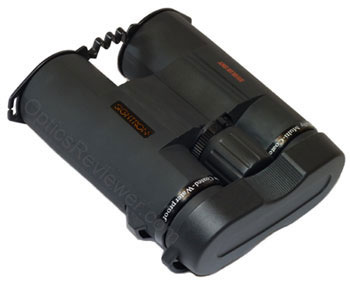
Given your present understanding of our love of a wide field of view, you'll understand that we found our 10X42's 361ft (121m) field of view at 1,000yds/m an average one. The 8X42's field of view is even greater and the respective fields of view for the 32mm configurations are equally enjoyable.
What softness there is around the periphery of the field of view is largely able to be brought into sharp focus by adjustment of the focus wheel. (The area of softness is thus primarily due to field curvature.)
The bird watcher viewing a moving subject or a plane spotter locating a plane aloft will enjoy the field of view. A sports enthusiast watching a fast-paced stadium competition or a racing fan will love the amount of action able to be viewed. The hunter will value the amount of activity visible without moving and the tourist on a sight-seeing safari will revel in the view. Need we say more?
Unfortunately, Sightron USA's web site and literature lists the 8X32 Blue Sky as having a 420ft (140m) field of view (FOV) at 1,000yds/m — or an 8.0° angular field of view. We've seen pictures showing the 8X32 binocular's focus wheel where it says that the field of view is 7.5°. When calculated out, this is a 395ft (131m) FOV at 1,000yds/m. We understand that 8X32 Blue Sky owners have alerted Sightron USA to this, but the error remains uncorrected. Given the quality of the binoculars, we hesitate to believe an indifferent attitude exists at Sightron Japan!
The High Resolution Zone in the Field of View
There is always a portion of the field of view that's particularly well focused and where details are more readily apparent. That area is usually in the middle of the field of view and binocular users have become somewhat accustomed to referring to it as the "sweet spot."
We found with our test model, that the crisp, sharp details visible in the center of the field of view started to soften almost imperceptibly at about 57% of the radius of the field of view. At about 64% of the radius of the field of view, the details began to get a bit fuzzy. It's good. We could still use the soft and fuzzy areas for locating an image to view, but the details of the view were much clearer in the center of the view.
The crisp resolution of details is enhanced by the optics being fully multi-coated, the use of BaK-4 glass for the prisms, and phase correction coating.
We didn't notice any significant distortion that anyone would be likely to notice quickly, but thought that we were able to discern a very slight amount of barrel distortion. It was not, we hasten to add, nearly enough for us to call it "rolling ball" or "globe distortion" and was only discernible when we intentionally looked for it!
Colors
Colors viewed with our test Blue Sky were rich. The view offered by our test model appeared to be minimally warm-biased, although it was not apparent unless comparing it with a neutral or cool-biased instrument. This is not entirely surprising, since reflective prism coatings of silver alloy typically reflect colors in the warmer spectrum more effectively. What was surprising was that it wasn't easy to discern!
When viewing dark wires or bare branches against a bright sky, they appeared to be fringed with yellow or blue/purple color. This chromatic aberration was not generally evident if the bright background were missing. We considered our test binocular's performance for color fringing to be about average or a bit above average.
Low Light Viewing
It's in low light viewing that we felt the SII Blue Sky series binoculars functioned particularly well. When comparing our test instrument against others with silver alloy reflective prism coatings, the Blue Sky instrument was superior in providing meaningful images under low light conditions. Not only was it superior under low light conditions, it was also superior at significant distances in those low light conditions.
Sightron told us that the reflective prism coating is proprietary and they don't generally discuss it beyond saying there are four "phased silver" coatings. We understand it to be a silver alloy, the composition and application of which are proprietary (as is usually the case) and it appears to provide superior results.
Our test binocular was not only better at seeing in overall low light conditions, but it was better at looking into shadowed areas during broad daylight. When we looked from an open, well-lighted area into darker, shadowed areas under dense tree foliage, we were able to see better with our Sightron binocular than with binoculars in its category.
Glare Observed While Using in Strong Light
While our Sightron SII Blue Sky was very good at handling strong daylight as compared to others in its category, it was possible to induce glare by achieving a sufficiently narrow angle to the light source — as with most binoculars. In this area, however, we consider our test binocular to be significantly above average and others have indicated a similar experience.
When viewing bright street lamps or parking lot lights at night, the ability to deal with this lighting condition was about average.
Overall, it was a lot of fun using our test instrument to watch wildlife at dawn or twilight.
Close Focus
While Sightron specifies an 8.5ft (2.6m) close focus for our 10X42 configuration, we found that ours was capable of a 6.8ft (2.1m) close focus. Even at the 8.5ft specification figure, it's very near to our ideal of 8.0ft or less for bird watchers who wish to see details of relatively nearby birds.
For the 8X32 SII Blue Sky configuration, the Sightron USA web site specifies 18.0ft (5.5m) as the close focus distance. We understand from users that this is an error — the close focus distance is significantly less than 18ft and the actual close focus is typically quite comfortably under 10.0ft (3.1m). (You'll notice that the close focus specification for the 10X32 is nearly 50% less: 10.0ft/3.1m.)
Diopter Adjustment
These binoculars can be readily adjusted to compensate for the differences in vision which commonly exist between an individual's two eyes.
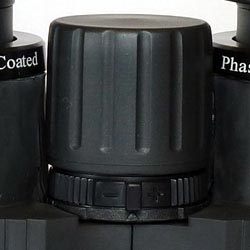
For the instruments with 42mm objective lenses, this is done via an adjusting ring between the focus wheel and the binocular's hinge. The ring has a protruding nub which is shifted to the left or right for diopter adjustment. The right barrel's optics are the ones adjusted by the diopter adjustment, so the traditional viewing through the left barrel first (while adjusting the focus wheel) and then viewing through the right barrel (while moving the diopter adjustment) is appropriate.
It initially appears that such an adjusting arrangement would be subject to being unintentionally moved. That may be possible, when considering brushing up against branches in the woods, for example, but the ring actually has a reasonable amount of resistance and it clicks solidly with each small adjustment. We didn't find any problem with the diopter "self-adjusting" when least expected or desired.
The binoculars with 32mm objectives have their diopter adjustment in the form of a ring by the right eyecup.
Three-dimensional Effect or Depth of View
The depth of view, or depth of focus, is very good as compared to others in the Blue Sky's general category. We found that we had only to come to an approximate focus initially and that it was quite an easy matter to finalize the focus without "rocking back and forth" due to our test instrument's depth of view.
Is the depth of view as good as a person might see with a Porro prism design binocular? No, while it's actually very good for a roof prism in its category, it isn't quite that good. Bottom line on this binocular's depth of view — we like it a lot.
What Comes With It?
There are some items that come with the binocular, as is commonly the case, which enhance the owner's experience.
Carrying Case and Incidentals
A sturdy-feeling, lightly-padded nylon carrying case is included with a surface that gives the impression that it will easily tolerate rough treatment by things like branches. Although we were able to get the binocular in and out of the case, we felt the case was a bit more snug than necessary. We found it worked better to carry the binocular un-cased when in areas where we expected to use it.
It does not have a belt loop or other means of easily keeping it nearby when the binocular isn't inside it. This is a small thing that we feel would add significant value. Still, all in all, it doesn't seem like a big enough problem to discourage a person from considering the binocular.
The neck strap is rather plainly made of inch-wide, sturdy, nylon web material which seems very serviceable. It would take a good bit of use to wear it out. Although it's not fancy, we liked it and felt it was further evidence of a durably made product.
A microfiber lens-cleaning cloth is included in the package. (We find that we actually prefer the cleaning ability
of a lens pen
to that of most micro-fiber cloths.)
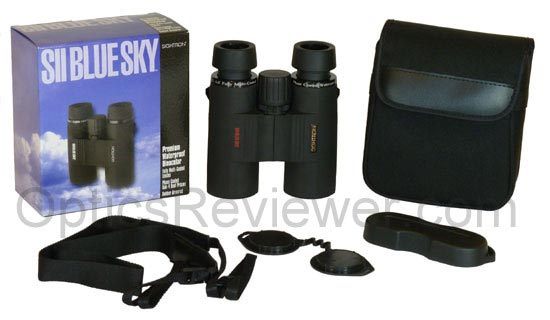
Rain Guard and Lens Covers
The rain guard fits smoothly and quickly over the oculars at whatever inter-pupillary distance their setting might be. It connects to the neck strap on the left end. It's an ultimately practical design and does well at covering the lenses.
The covers for the objective lenses which were included with our binocular were designed to fit the inside diameter of the barrels and stay there by friction. Unfortunately, the design is a difficult one to make stick and ours stayed in place only with difficulty. We took them off and left them in the box and didn't feel as though we suffered without a cover for the objective lenses, since they're rarely in a position to attract rain or debris.
Recommendation
Is it the perfect budget, roof-prism binocular? No, we hate to say it, but it isn't. However, while it may not do any particular thing outstandingly, it does everything quite well. Of the binoculars we've tested in the same category as the Sightron SII Blue Sky, we felt the Blue Sky presented an especially good value.
The ease of handling, its low light capabilities along with the field of view, depth of view/focus, and resolution of details, for example, overcome the shortcomings to make this an excellent binocular in its category.
Bird watchers, hunters, sports enthusiasts, folks who like to keep up with what's happening in the community — it's hard to think of anyone who wouldn't find the Sightron SII Blue Sky binoculars a solid optical value.
What's the Sightron Warranty Like?
The Sightron SII Blue Sky binoculars are covered by the Sightron Lifetime Warranty against defects in materials or workmanship.
Here are the company's specifications (corrected for the 8X32's field of view as noted above) for both of the SII Blue Sky binocular configurations. In keeping with the January 2014 update (above) regarding Sightron USA's having discontinued the SII Blue Sky configurations with 42mm objective lenses, the 42mm configurations have been removed from the following table.
| Configuration | 8X32 | 10X32 |
| Prism Coating | Silver Alloy | Silver Alloy |
| Field of View at 1,000 yd/m ft/m | 395/131 * | 342/114 |
| Close Focus Distance ft/m | 10.0/3.1* | 10.0/3.1 |
| Exit Pupil (mm) | 4.0 | 3.2 |
| Relative Brightness | 16.0 | 10.2 |
| Eye Relief (mm) | 17.5 | 15.0 |
| Weight oz/g | 19.8/ 561 | 19.8/ 561 |
| Inter-pupillary Distance (mm) | 54-75 | 54-75 |
*- as indicated by customers or our testing, although it may differ from what the Sightron USA catalog or web site indicate. These items are discussed in the review above.
If you're wondering about choosing a binocular from an optical company you're not familiar with, you'll probably appreciate the comparison of the Sightron SII Blue Sky vs Nikon Monarch 3.
Home > Sightron SII Blue Sky Binocular Review


Your Comments
This site is for you, our readers. We appreciate your comments very much.